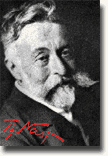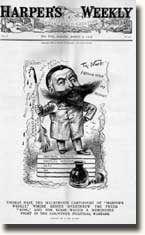
Have you ever seen a drawing that made you laugh, cry, or cringe? Have you seen a cartoon sketch that gave you a brilliant idea or made you change your opinion about something? Who would think that simple artwork could make a difference in someone’s life. The artwork of the renowned German-American, Thomas Nast, has changed the lives of many. His drawings influenced the future course of your nation’s history!
Born in Landau in der Pfalz, Germany in 1840, young Thomas Nast came to America when he was only six years old. Entering one of New York City’s public schools, he did not speak one word of English. Many of the children teased little Thomas. He did not enjoy school, nor the schoolwork. Thomas found it difficult to adjust to his new life in America, but reminded himself of the first day he stepped off the boat and how excited he was to finally arrive there. He hoped that he would again soon feel happy at the thought of America.

Thomas’ talent for drawing was soon found. Given reject crayons from a store owner, Nast would spend hours drawing pictures instead of doing his schoolwork. His talent was discovered by his classmates and teacher. This was little Thomas’ first triumph as an artist, his first moment of victory in the New World. Encouraged by a teacher, six years later, Nast was transferred to an art school where he demonstrated extraordinary talent for being so young. Unfortunately, at the age of fifteen, he had to leave his art school to help support his family. Nast then took his talent and sought employment.
Because of his young age and his short and fat stature, it was difficult for him to find manual labor. Instead, he decided to use his talent for drawing and sought a job as an illustrator. With pure boldness, Nast walked into the offices of Frank Leslie’s Illustrated Newspaper. Finding his request out of the ordinary, Leslie gave Nast an assignment to draw a picture during rush hour on Christopher Ferry Street Ferry house in Manhattan. Nast returned with his drawing the next morning. Leslie was impressed with Nast and quickly hired him. Though he was quite young for that sort of work, his determination and talent won him a job. For three years Nast worked for Frank Leslie and earned four dollars a week. During his years with Leslie, Nast drew his first cartoon attacking civic corruption, a theme that was to bring him fame in later years.
At the age of twenty-one, Nast had made a name for himself with his drawings and was working hard for Harper’s Weekly. The year he was twenty-one was the first year of the Civil War. Given the assignment to draw on-the-scene sketches at the front, Nast began expressing his personal views on the war through his cartoons. These sketches first attracted nationwide attention to his work. Abraham Lincoln commented on Nast’s work saying, "Thomas Nast was our best recruiting officer." His powerful cartoons stirred people into action. gallery 1
Following the close of the war for twenty-five years, Nast expressed his views of every national issue of political and social significance through his cartoons. All the presidential candidates whom he supported were elected, and the attack of the "Tweed Ring" in New York City added to his fame. No cartoonist ever made a more powerful set of cartoons against the Tweed Ring than that of Nast. About 45 drawings revealed the corrupt scheme headed by William "Boss" Tweed. This political ring plundered the city, robbing it right and left. Boss Tweed then divided the loot with his ring of friends. Unnerved by the situation, Nast’s cartoons against the vicious Tweed Ring appeared in Harper’s Weekly week after week until the ring’s eventual disposal. gallery 2
Thomas Nast was the creator of familiar symbols used throughout the United States. The big elephant that stands for the Republican party or the "Grand Old Party," was first drawn by Nast. His creation of the symbol for the Democratic party appeared four years earlier. The long-eared animal was first called a plain "jackass," but later became a more respectable and dignified "donkey." The "Tammany tiger" which was also used in political campaigns was also created by Nast, along with the "labor cap" and the "full dinner pail," symbols used often in the newspapers. gallery 3
Although one would think, not all Nast’s popularity came from his political cartoons. Nast is well-known for his Christmas drawings. Harper’s Weekly’s Christmas issue of 1862 unveils the first appearance of Santa Claus as we know him today. Through the vision of Clement Moore’s poem "Twas the Night Before Christmas," Nast created the image of Santa Claus on paper.
Nast became a wealthy man through is drawings for Harper Weekly and through popular lectures in which he rapidly drew on a large sheet of paper as he spoke. For the year of 1880, Nast’s income was almost as much as that of the president’s. But unfortunately, his wealth did not last very long. After leaving Harper’s Weekly because of disagreements with a new editor, debts piled up. Unsuccessful business ventures and misfortunes left him in financial hardship. His income was not enough to support his family. An admirer of Thomas Nast, President Theodore Roosevelt offered him a government post as consul to Ecuador. Nast accepted the call and sailed to the tropical country alone. There, through the heat and unsanitary living conditions, Nast contacted yellow fever and died at the age of sixty-two. Though his death was tragic and lonely, Thomas Nast has left a splendid record of accomplishments. His artistic talent has given him honor to his name. This German-American has led the way for many brilliant artists and cartoonists in America!
